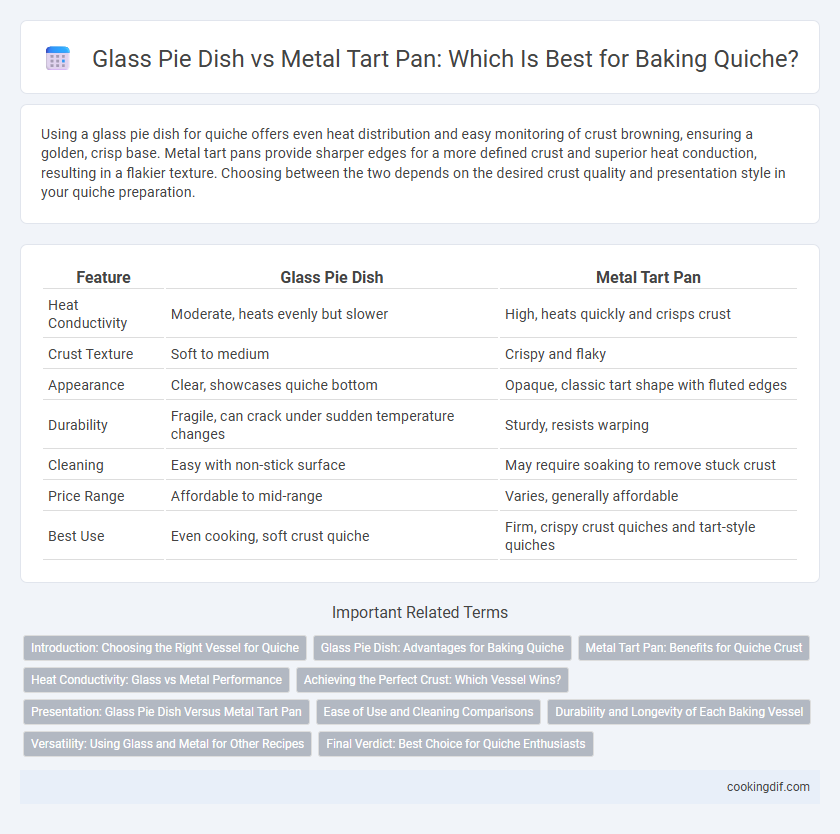Using a glass pie dish for quiche offers even heat distribution and easy monitoring of crust browning, ensuring a golden, crisp base. Metal tart pans provide sharper edges for a more defined crust and superior heat conduction, resulting in a flakier texture. Choosing between the two depends on the desired crust quality and presentation style in your quiche preparation.
Table of Comparison
| Feature | Glass Pie Dish | Metal Tart Pan |
|---|---|---|
| Heat Conductivity | Moderate, heats evenly but slower | High, heats quickly and crisps crust |
| Crust Texture | Soft to medium | Crispy and flaky |
| Appearance | Clear, showcases quiche bottom | Opaque, classic tart shape with fluted edges |
| Durability | Fragile, can crack under sudden temperature changes | Sturdy, resists warping |
| Cleaning | Easy with non-stick surface | May require soaking to remove stuck crust |
| Price Range | Affordable to mid-range | Varies, generally affordable |
| Best Use | Even cooking, soft crust quiche | Firm, crispy crust quiches and tart-style quiches |
Introduction: Choosing the Right Vessel for Quiche
Glass pie dishes provide even heat distribution and excellent visibility, allowing precise monitoring of quiche browning, while metal tart pans, often with removable bottoms, offer superior crispiness and easier serving. Metal pans conduct heat more rapidly, creating a golden, flaky crust essential for traditional quiche texture. Selecting between these vessels depends on preference for crust crispness versus baking control and presentation.
Glass Pie Dish: Advantages for Baking Quiche
Glass pie dishes offer superior heat retention, ensuring even cooking and a perfectly set quiche filling. Their transparent nature allows bakers to monitor browning and crust doneness, preventing overbaking. Glass also distributes heat more gently than metal tart pans, minimizing the risk of burnt crust edges while achieving a tender, flaky texture.
Metal Tart Pan: Benefits for Quiche Crust
Metal tart pans provide superior heat conduction, resulting in a crispier and evenly browned quiche crust compared to glass pie dishes. The raised edges and removable bottoms of metal pans allow for easier crust shaping and extraction, enhancing presentation quality. Their sturdy structure supports uniform baking, preventing soggy bottoms common in glass dishes, especially in custard-rich quiches.
Heat Conductivity: Glass vs Metal Performance
Glass pie dishes provide even heat distribution, resulting in a uniformly cooked quiche but tend to heat slowly and retain heat longer, which may cause overcooking if not monitored. Metal tart pans, particularly aluminum or steel, offer superior heat conductivity, heating quickly and promoting a crispier, well-browned crust ideal for quiche recipes. Choosing between glass and metal depends on desired crust texture and precise control over baking time due to their differing thermal properties.
Achieving the Perfect Crust: Which Vessel Wins?
Glass pie dishes provide even heat distribution that helps achieve a golden, crispy crust for quiche, while metal tart pans excel at conducting heat quickly, resulting in a flakier, more textured base. The metal tart pan's removable bottom also allows for easy release and presentation, enhancing the quiche's structural integrity and appearance. For optimal crust perfection, the choice depends on whether a tender, evenly browned crust or a crisp, flaky texture is preferred.
Presentation: Glass Pie Dish Versus Metal Tart Pan
A glass pie dish offers a clear view of the quiche's golden crust and vibrant filling, enhancing visual appeal and making it ideal for showcasing layers. Metal tart pans provide a crispier, evenly browned crust with fluted edges, delivering a polished, restaurant-quality presentation. Choosing between glass and metal depends on whether transparency or textured elegance best suits the quiche's aesthetic.
Ease of Use and Cleaning Comparisons
Glass pie dishes offer excellent heat retention and allow easy monitoring of quiche browning during baking, while their smooth surface simplifies cleaning and prevents sticking. Metal tart pans heat more quickly for crispier crusts but often require greasing and thorough scrubbing to remove baked-on residue. Choosing between glass and metal depends on prioritizing even cooking with hassle-free cleanup or achieving a crispier crust with more intensive maintenance.
Durability and Longevity of Each Baking Vessel
Glass pie dishes offer excellent durability with resistance to rust and corrosion, maintaining their integrity over years of use. Metal tart pans, often made from aluminum or steel, provide lasting strength but are prone to dents and may require seasoning to prevent rust, potentially reducing longevity. Choosing between glass and metal ultimately depends on balancing the desire for consistent heat conduction with the vessel's resistance to wear and tear over time.
Versatility: Using Glass and Metal for Other Recipes
Glass pie dishes offer excellent heat distribution, making them ideal for custards and delicate baked goods, while metal tart pans provide a crispier crust with their superior conductivity, perfect for savory quiches and tarts. Glass vessels are versatile for recipes that require even baking without browning the edges too quickly, such as casseroles and pies. Metal pans, often equipped with removable bottoms, facilitate easy serving and are also well-suited for recipes needing thorough browning and a firm crust.
Final Verdict: Best Choice for Quiche Enthusiasts
Glass pie dishes provide consistent heat distribution and a clear view of the quiche's browning process, enhancing precision during baking. Metal tart pans with removable bottoms offer superior crispiness and elegant presentation, making them ideal for quiches requiring a delicate crust. For quiche enthusiasts prioritizing even cooking and aesthetic appeal, metal tart pans represent the best overall choice.
Glass pie dish vs metal tart pan for quiche vessel Infographic

 cookingdif.com
cookingdif.com